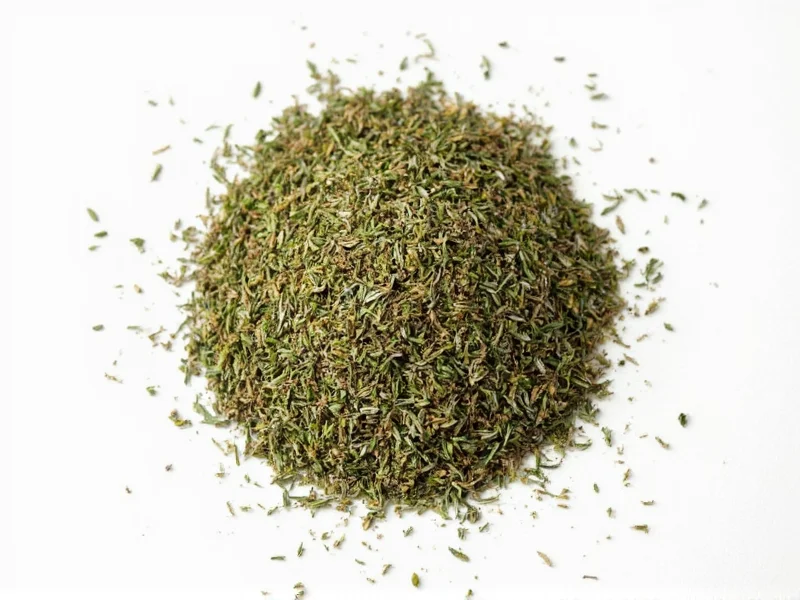Understanding herb conversions is essential for consistent cooking results. Many home chefs mistakenly apply fresh-to-dried conversion rules to dried-to-ground substitutions, leading to imbalanced flavors. This comprehensive guide clarifies the precise relationship between dried thyme leaves and ground thyme, helping you achieve perfect seasoning every time.
Understanding Dried Thyme vs Ground Thyme
Dried thyme refers to whole or broken leaf pieces that have been dehydrated, while ground thyme is the same dried herb processed into a fine powder. The key distinction lies in texture and dispersion, not potency. Both forms contain the same essential oils and flavor compounds since neither involves additional processing that would alter concentration.
This differs significantly from fresh-to-dried conversions, where moisture loss concentrates flavors. With dried-to-ground transitions, you're merely changing physical form—like using granulated versus powdered sugar. Professional chefs confirm that dried thyme to ground thyme conversion maintains identical flavor impact when measured by volume.
Practical Conversion Guidelines
When following recipes that specify one form but you only have the other, use these straightforward substitution rules:
| Recipe Calls For | You Have | Conversion | Example Measurement |
|---|---|---|---|
| Dried thyme leaves | Ground thyme | 1:1 | 1 tsp dried = 1 tsp ground |
| Ground thyme | Dried thyme leaves | 1:1 | 1/2 tbsp ground = 1/2 tbsp dried |
| Fresh thyme | Dried thyme or ground thyme | 3:1 | 1 tbsp fresh = 1 tsp dried/ground |
When Texture Matters More Than Flavor
While the dried thyme to ground thyme conversion ratio remains consistent for flavor purposes, texture considerations may influence your choice:
- Rubbed into meats: Ground thyme distributes more evenly in spice rubs
- Infused sauces: Dried whole leaves are easier to strain from liquids
- Baked goods: Ground thyme blends seamlessly without textural distraction
- Long-cooking dishes: Dried leaves maintain some structure while ground thyme fully integrates
For most applications, the choice between dried thyme leaves and ground thyme comes down to personal preference and recipe requirements rather than potency concerns. This understanding of dried thyme versus ground thyme measurements prevents common seasoning errors that can ruin otherwise excellent dishes.
Storage and Shelf Life Considerations
Both forms share similar storage requirements but differ slightly in longevity:
- Store in airtight containers away from light and heat
- Ground thyme loses potency faster (6-12 months) due to greater surface area exposure
- Dried whole leaves maintain flavor longer (1-2 years) when properly stored
- Test freshness by rubbing and smelling—vibrant aroma indicates good quality
When substituting older dried thyme for ground thyme in recipes, you might need to increase the amount slightly due to natural flavor degradation over time. This exception to the standard dried thyme to ground thyme conversion ratio applies only to herbs past their prime.
Expert Tips for Perfect Seasoning
Professional chefs recommend these practical techniques when working with thyme conversions:
- Bloom ground thyme: Briefly toast ground thyme in oil before adding liquids to maximize flavor release
- Crush dried leaves: Rub dried thyme between palms before adding to release essential oils
- Add timing matters: Add ground thyme earlier in cooking; add dried leaves later for brighter flavor
- Taste and adjust: Always taste before final seasoning, especially when substituting forms
Understanding when to use ground thyme instead of dried thyme can transform your cooking. While the basic conversion remains straightforward, these subtle techniques help you leverage each form's unique properties for optimal results. Remember that dried herb conversion to ground spices follows this same 1:1 principle across most woody herbs like rosemary and oregano.
Avoiding Common Conversion Mistakes
Cooks frequently make these errors when handling thyme conversions:
- Mistaking dried-to-ground conversion for fresh-to-dried (applying 3:1 ratio unnecessarily)
- Compensating for texture differences by altering measurements
- Using volume measurements for degraded herbs without adjustment
- Confusing thyme with more potent ground spices like cloves or cinnamon
The thyme conversion chart for recipes should remain simple: equal parts by volume. Save measurement adjustments for when you're working with herbs past their prime or substituting between fresh and dried forms.











 浙公网安备
33010002000092号
浙公网安备
33010002000092号 浙B2-20120091-4
浙B2-20120091-4